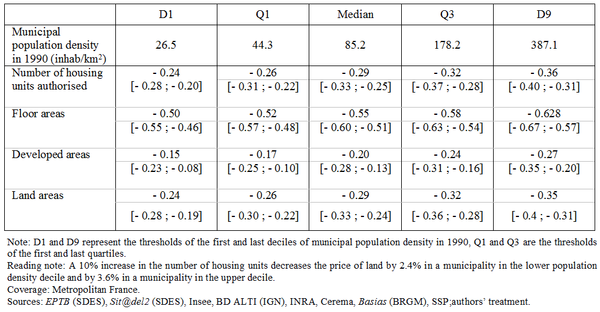Economie et Statistique / Economics and Statistics n° 500-501-502 - 2018 Does issuing building permits reduce the cost of land? An estimation based on the demand for building land in France
THE ARTICLE ON ONE PAGE
Key question
In France, the value of built land increased from 45% to almost 260% of gross domestic product between 1998 and 2006, stabilizing at slightly lower levels after the crisis (222% in 2016). This inflation of land price has affected houseprices, which have also seen high inflation. To what extent does the issuance of building permits relax this constraint on available land and so reduce its price? It is essential to analyse this mechanism to evaluate the effectiveness of policies designed to promote construction in order to limit the growth of household expenditure on housing.
Methods
Using a theoretical model seeking the best match between heterogeneous households (in terms of preferences) and heterogeneous building plots (in terms of location), an inverse demand function for building land (price) is estimated by instrumenting construction (quantity) by variables relating to the type of land, its topography, the agricultural opportunity cost and the presence of industrial brownfields. The data are drawn mainly from the building land price survey (EPTB, Ministère de la transition écologique et solidaire) 2006-2014 and the Sit@del2 information system on building permits.
Main results
- A 1% increase in built areas leads, on average, to a change in the price of building plots of -0.3% (+/- 0.1 of percentage point).
- The effect is greater in absolute terms for buildings located near urban centers, the proximity of which is valued positively by households. In the densest municipalities (more than 387 inhab./km²), the price elasticity of land therefore exceeds, by more than 0.1 of percentage point in absolute terms, the estimated value for the least dense municipalities (less of 26 inhabitants/km²).
- Prices respond more significantly to increases in the floor areas of housing units (than to increases in the number of housing units or the area of land authorized for construction), meaning that this is a quality which is valued by households.
graphiqueVariations in the price of building land (%) for a 1% increase in the number of housing units built, floor areas built, developed areas and plot areas

Main message
This study highlights the significant, albeit modest, impact of policies aimed at lowering the price of land by increasing the construction of new housing units. To make these policies more effective, the results argue for targeting construction in relatively denser areas closer to urban centres and jobs. They also highlight the interest of an increase in available floor area, while quality of construction is particularly appreciated by households.
Article on one page (pdf, 116 Ko )



